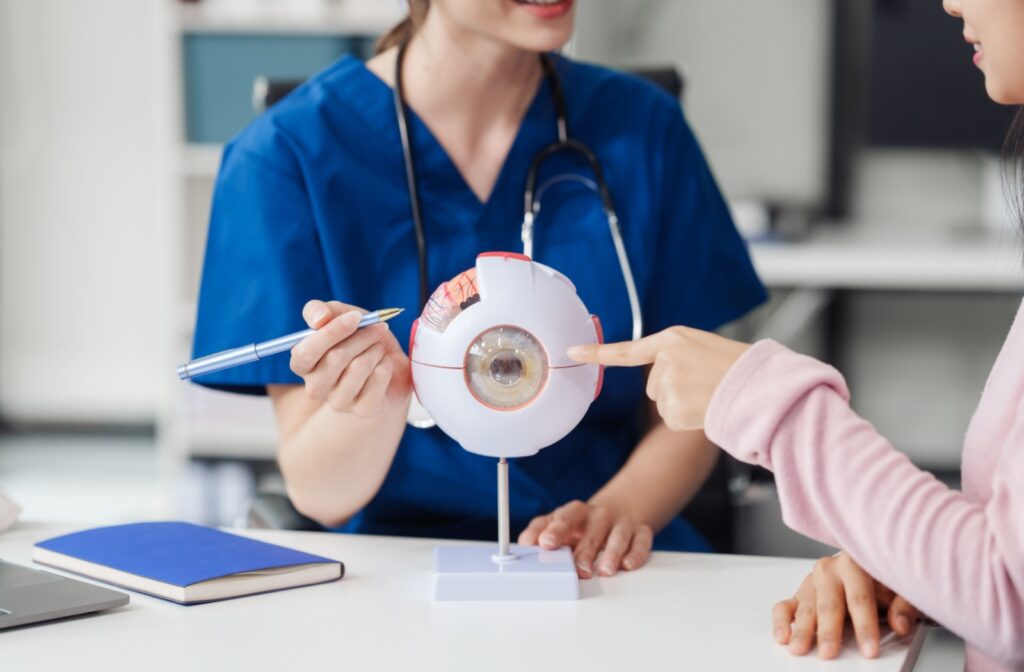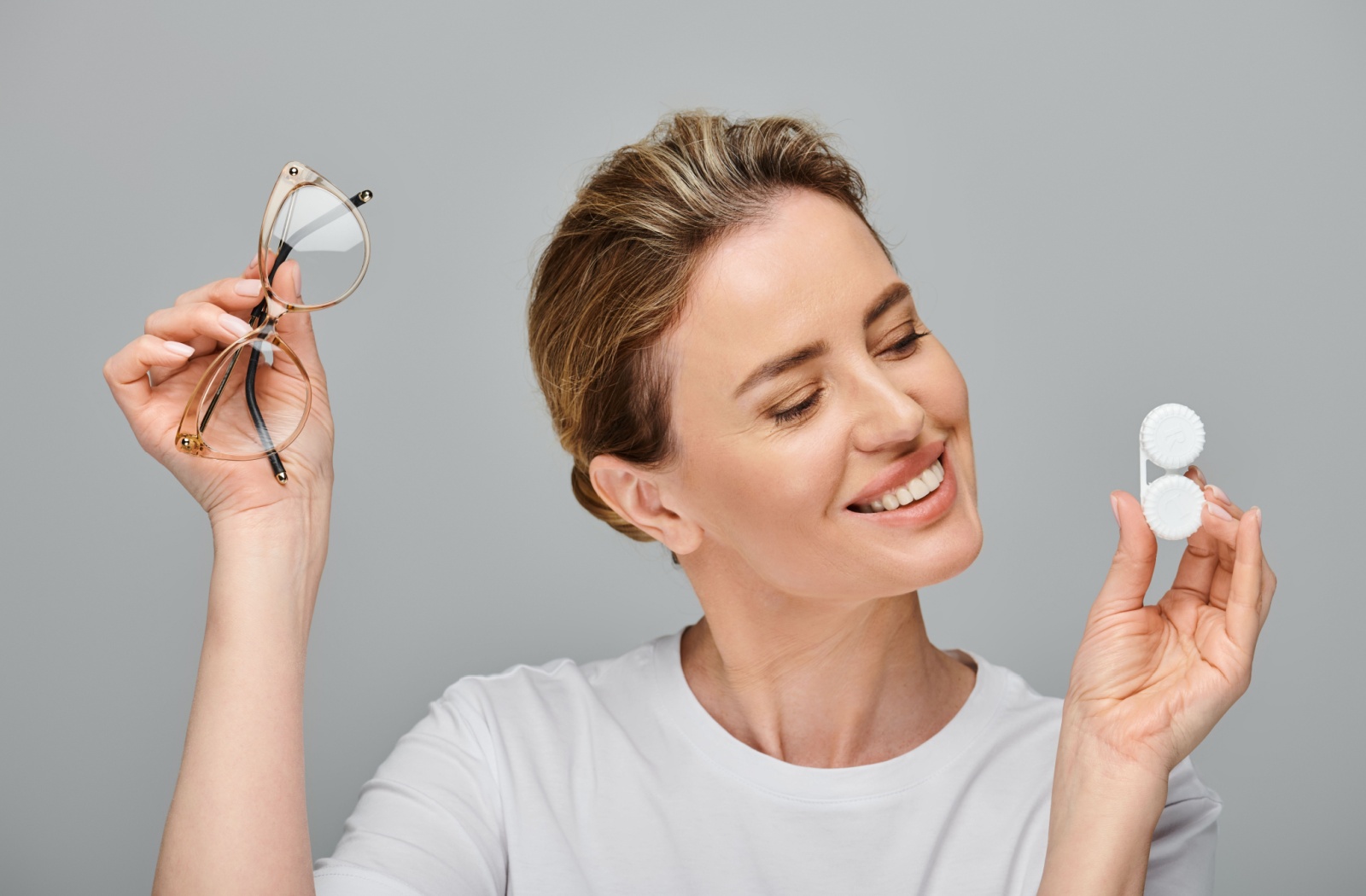Contact lenses and eyeglasses serve as the primary and preferred method for vision correction for most people.
They both correct refractive errors by changing the way light enters the eye, allowing light to focus directly on the retina. While the mechanism is the same, glasses and contacts have different prescriptions. These values aren’t interchangeable.
The prescriptions are similar but different. Eyeglasses sit a few millimeters away from our eyes, on the bridge of our nose, while contacts sit directly on the eye’s surface, so they require slightly different prescriptions.
Understanding Contact Lenses
Contact lenses are optical devices that help provide clear vision, which rest directly on the eye’s surface, making them different from traditional eyeglasses, which sit further away from the eye’s surface.
Contacts are thin, curved, clear lenses that enhance visual clarity. Their lightweight design makes them unnoticeable to the wearer, making them a popular choice for vision correcting for active individuals, or those who prefer not to wear glasses.
Contact lenses correct refractive errors by directly aligning with the curvature of the cornea, helping focus light directly onto the retina. By sitting directly on the eye, contact lenses provide a subtle yet effective solution for correcting vision.
While contacts provide many benefits, the nature of these devices can mean that they’re not suitable for everyone. Conditions like dry eye syndrome, allergies, or certain corneal irregularities may render the use of contacts uncomfortable or unsafe.
However, to address different needs and preferences, there are several different types of contacts available, including soft contact lenses (a popular choice), hard gas-permeable contacts, and scleral contacts. Your optometrist will be able to suggest a contact lens option to suit your vision needs.
Why Do Contacts And Glasses Have Different Prescriptions?
Glasses and contacts have different prescription values. The prescriptions are very similar, but you may notice a slight difference in the numbers. Typically, contact lens prescriptions may be slightly stronger or weaker than glasses prescriptions depending upon the type of refractive error.
This is because of the difference in the distance between the corrective lens device and the eye. Glasses sit a few millimeters away from the eyes, while contacts are placed directly on the cornea. The difference in placement means that the strength of the lenses has to be adjusted accordingly.
With contacts, the prescription is slightly weaker to account for the lack of distance between the lens and the eye. For example, a glasses prescription with a power of -4.50 diopters might be adjusted to -4.25 diopters for contact lenses. Plus, contact lens prescriptions include measurements for the curvature and diameter of the lens, which are not part of a glasses prescription.

Differences Between Contact Lenses And Eyeglasses
Like all available choices for any decision, both glasses and contact lenses have advantages and disadvantages. Learning about their differences can help determine whether both options are compatible with your daily vision needs, or if you’d rather stick to one over the other.
Comfort
Glasses are convenient. They’re easy to put on and take off. However, glasses rest on the nose and ears, which can sometimes cause discomfort, especially if worn for extended periods. The frames can also loosen over time.
People with high vision prescriptions might have glasses with noticeably thick lenses. Some frames may also be heavier than others. Over time, eyeglasses can feel heavy.
Contact lenses, on the other hand, are light and sit on the eye’s surface. When fitted correctly, it can be comfortable for all-day wear. However, improper use or extended wear of contacts can lead to dryness and irritation. For those with dry or sensitive eyes, certain contact lenses might be uncomfortable.
Vision Correction
Both contact lenses and glasses effectively correct vision, but they do so in different ways. Both devices correct vision by aligning the way light enters the eye, allowing light to focus directly on the retina.
Glasses sit on the bridge of our nose, a few millimeters away from our eyes while contact lenses sit directly on the cornea. This difference in distance affects the prescription strength required.
Contacts sit directly on the eye and move with it, providing corrective vision for peripheral view. They also eliminate the visual distortions and reflections that can occur with glasses, offering a more stable and consistent field of vision.
Which Is Better?
The choice between contact lenses and glasses depends on personal preference and lifestyle. Glasses are easy to wear and maintain and can make a fashion statement.
Contact lenses can correct peripheral vision since they sit directly on the eye. This positioning can allow light to focus accurately onto the retina, reducing distortions that can occur with glasses.
Some contact lenses can be worn for up to 6 days at a stretch. This is due to the advent of silicone hydrogel lenses, which are better at letting oxygen through the lens to your eyes.
Glasses are easier to wear for lengthy periods without the associated risk of eye irritation. Plus, they’re easier to take on and off.
Schedule A Contact Lens Fitting
Since glasses and contact lenses have different prescriptions, they require different exams to help confirm these values. This is why undergoing a contact lens fit is important.
Connect with our team at Dr. Jennifer L. Shane & Associates to schedule your contact lens fitting!



